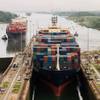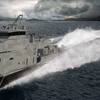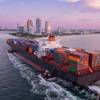Panama Canal Expansion Allows More NGL Transists
In June 2016, the Panama Canal Authority, the body that operates the Panama Canal, opened a third set of locks that facilitated transit of larger ships, the first such expansion since the canal was completed in 1914.
In the years since the canal was expanded, the largest change in petroleum flows through the canal has been the increase of hydrocarbon gas liquids (HGL), especially propane, from the U.S. Gulf Coast to destinations in Asia. HGL represents all natural gas liquids (NGL) and olefins.
Most of the petroleum transiting the Panama Canal travels southbound from the Atlantic Ocean to the Pacific Ocean. Flows of HGL are the largest single petroleum commodity transiting the canal, according to data from the Panama Canal Authority. In 2018, about 387,000 barrels per day (b/d) of HGLs moved southbound through the Panama Canal, compared with 266,000 b/d of distillate and 230,000 b/d of motor gasoline.
Before 2016, the main constraint for increasing U.S. HGL exports was export infrastructure on the U.S. Gulf Coast. By 2016, the addition of Gulf Coast export infrastructure alleviated this constraint, and the size limitations of the original Panama Canal locks, and the costs associated with alternative shipping routes became the main constraints for increased exports.
The most economical way of transporting large volumes of HGLs by water is with Very Large Gas Carriers (VLGC). The shortest route from the U.S. Gulf Coast (where most U.S. HGL export capacity is located) to Asia (the largest destination for U.S. exports) is through the Panama Canal. However, the original set of Panama Canal locks were too small to allow most VLGCs to transit, so ships had to transfer cargo to smaller ships that could transit the canal, a process known as ship-to-ship transfers for U.S. propane exports destined for Asia.
After the canal’s expansion, VLGCs can now transit the larger set of canal locks. The growth in HGLs transiting the Panama Canal coincided with an increase in exports of HGLs from the U.S. Gulf Coast to destinations mostly in Asia. In 2018, four of the five largest destinations for U.S. Gulf Coast exports of HGLs were in Asia, with Japan being the largest at 280,000 b/d.
Export data show the destination of the products but do not provide information about the route. For some destinations, the route can be assumed: exports leaving the U.S. Gulf Coast for destinations in Europe most likely transit the Atlantic Ocean. Exports from the Gulf Coast to ports on the Pacific Coast of Central and South American countries likely go through the Panama Canal. For destinations in Asia, however, ships have many options: through the Panama Canal, through the Suez Canal, or around the southern tip of Africa.
Destinations on the Pacific Coasts of Central and South American countries such as El Salvador, Ecuador, Peru, and Chile received 382,000 b/d of crude oil and petroleum products from the U.S. Gulf Coast in 2018. This volume represented about 36% of the total 2018 southbound petroleum flow of petroleum products through the Panama Canal. For some products, the Gulf Coast’s volume share is much larger: U.S. Gulf Coast exports of distillate destined to El Salvador, Ecuador, Peru, and Chile made up 79% of all southbound distillate flow through the canal. For jet fuel, the share was 76%.
The most commonly used vessels to transport crude oil are too large to use the expanded Panama Canal. This restriction will likely limit flows of U.S. crude oil to destinations on the western coast of Central and South America. Instead, greater volumes of U.S. crude oil exports are more likely to go to destinations in Asia through the Suez Canal or around the southern tip of Africa and to destinations in Europe using trans-Atlantic routes.










